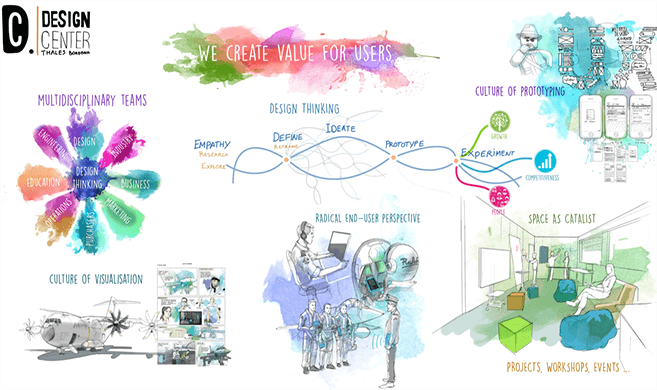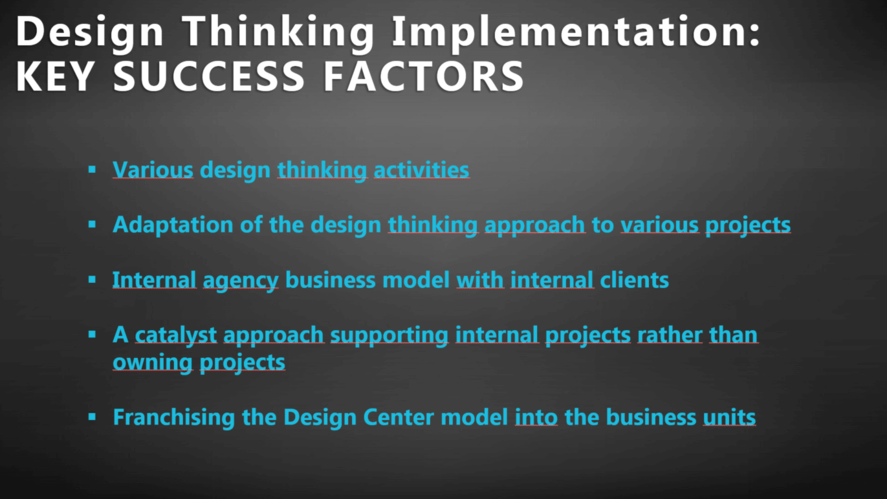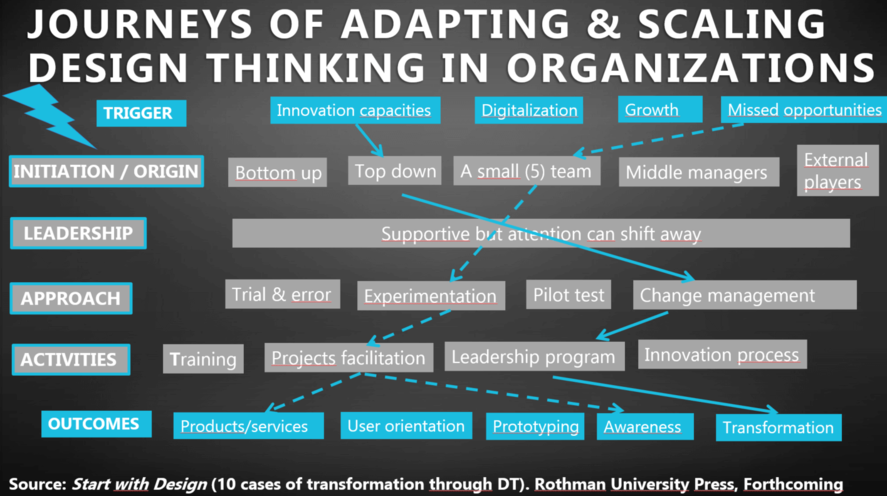Design thinking, a new fad or an innovation revolution?
Design thinking is a method for applying creative thinking to innovation. It represents a set of methods to stimulate innovation as well as an open mindset, to help reframe problems. It involves three core steps:
- Inspiration - An empathy phase that focuses on gaining deep insights about user needs.
- Ideation - A creative phase that focuses on generating solution options.
- Implementation - A prototyping phase that seeks to quickly weed out poor options and improve upon promising ones.
Design thinking exploded in popularity because the formula can be applied to virtually any industry. This has led to design thinking enthusiasts spreading praise of the phenomenon far and wide (as says the Harvard Business Review in this article). This has brought great benefits in terms of value creation. However, it also requires accepting a major change in the way work is organized: The focus of innovation has to shift from being engineering-driven to design-driven, from product-centric to customer-centric, and from marketing-focused to user-experience-focused.
The focus of innovation has to shift from being engineering-driven to design-driven.
The challenge of bringing creative design to an analytically minded firm
The authors set out to analyze an acid test for design thinking i.e. taking it right to the core of a technology-driven industry within the aerospace giant, Thales. What would happen when we brought design thinking to such an industry leader? After all, science- and technology-driven firms tend to see themselves as evidence-based environments where analytical thinking is the main driver of decisions. These are firms where innovation is critical and highly valued, when it occurs in technical R&D groups. Design thinking can be a challenge for such firms.
Thales started its Design Thinking journey with a 3-year partnership with the Stanford University’s “d.school”, something of a Mecca for design thinking. Standford’s d.school students worked on projects proposed by Thales over the course of their studies. While the results were promising, Thales didn’t choose to develop any of the students’ ideas. The key reason for the failure to bring any of the students’ hard work to fruition was that the students weren’t embedded in the teams that had the technological capability to develop their ideas.
In the words of one Thales manager, “We learned two things from this phase. The first one was that design thinking really works, and this was good news. The second one was that it was difficult to bring the [project] outcomes back inside the company. However, it created the conditions that allowed a few individuals to push the idea that we needed to internalize design thinking inside the company and create something.”
The training was delivered to more than 200 people and included in management leadership programs.
This provided the groundwork to conduct an experiment in 2012: setting up a 2,000 square foot open space within the Thales Corporate University with a €60,000 refurbishment budget where they ran a year-long trial to demonstrate the viability of bringing design thinking within the firm. The first Design Center was used to run design thinking training sessions and workshops and test whether design thinking could gain acceptance and build traction. The results surpassed the expectations, the training was delivered to more than 200 people and included in management leadership programs. 15 workshops and several projects later, one of the projects won an internal innovation award, attracted good press coverage for Thales, and provided an example of success used to pitch other divisions. The outcome of this project was a platform of concepts around the connected police officer such as a concept of a smart watch that was selected to move forward to the product design phase.
In the following two years, the experiment ballooned: 2,000 people were trained, 100 workshops were held and 10 projects were explored. A newsletter was launched presenting the principles of design thinking and featuring applications. Paris design center team grew to four full-time employees and two interns. They helped divisions interested in launching their own design facility. Now – eight years later, design-thinking support is available across the company and the design center’s revenue has increased 8-fold. The original team in Paris has grown to eight people plus interns and there are now a total of 12 design centers worldwide. Overall, the design center network employs more than 30 design thinking professionals with expertise ranging from industrial design to UX (user experience) design. The design centers have trained thousands of managers and engineers, provided hundreds of workshops, and delivered more than 50 projects with business lines engaging users and customers. The projects have led to new solutions in police technology, radar technician training, inflight entertainment systems, security domains, and air traffic control technology.
Design thinking is now integrated in the top management leadership program, and it has become instrumental in the digital and design transformation under way in the company.
4 lessons in discretion and pragmatism
Below are some lessons to share about the critical factors of this implementation:
1. Design thinking succeeds when it begins life under the radar
A key reason in the success of introducing design thinking throughout the company is the “under the radar” strategy: the design center was independent from the R&D department. As these players were not initially aware of the existence of the design center, a common roadblock to introducing design thinking to a company was avoided – the scepticism of the traditional gatekeepers to innovation.
2. Be flexible
The implementation succeeded because they didn’t go “by the book”. They were flexible in their mindset, adapting the design thinking approach however it was required to the nature of the project.
3. Be pragmatic and opportunistic
The project grew organically: pragmatic and opportunistic decisions led to growth and acceptance over time. Therefore, design thinking was demonstrated in action through projects showing benefits for business.
4. Play the role of catalyst
The divisions welcomed the approach enthusiastically because the design centers didn’t set out to take ownership of projects. They were catalysts working with the team from the business lines on their projects and supporting them methodologically.
The divisions welcomed the approach enthusiastically because the design centers didn’t set out to take ownership of projects.
Learn more from the IRI’s 2020 annual conference on "Making Design Thinking Work" where the authors were invited as guest speakers, online here, including this analysis by Professor Sihem Ben Mahmoud-Jouini:
Source: "Making Design Thinking Work, Adapting an Innovation Approach to Fit a Large Technology-Driven Firm".











